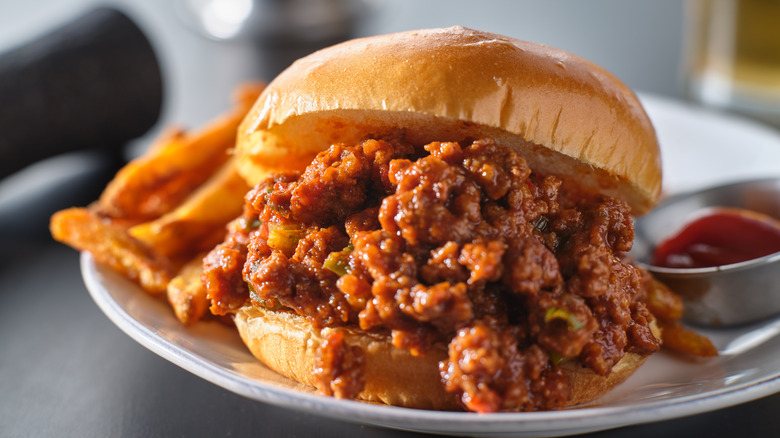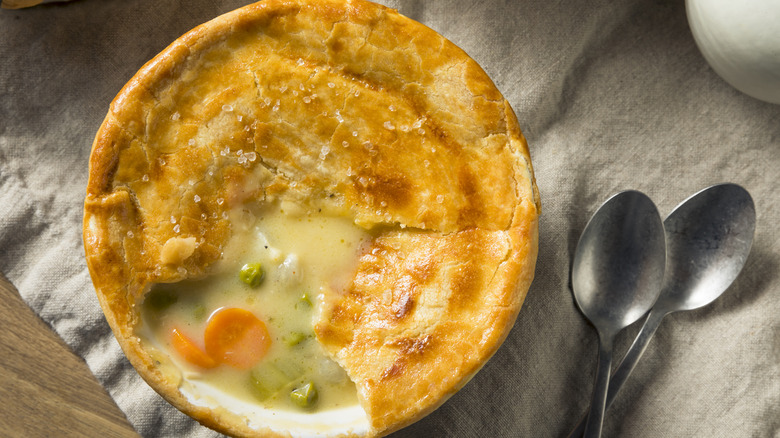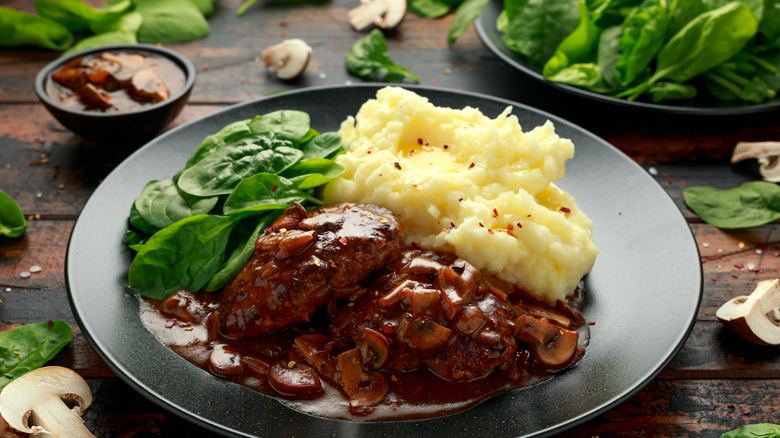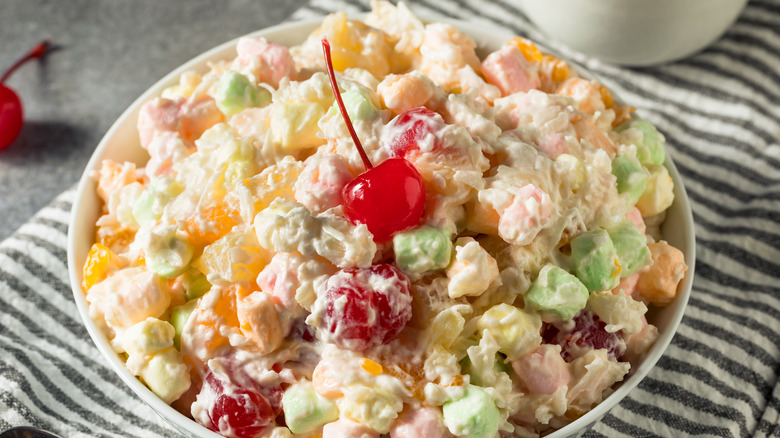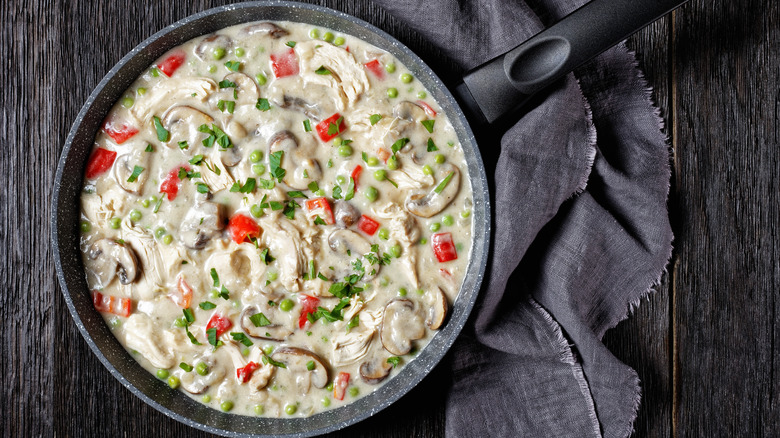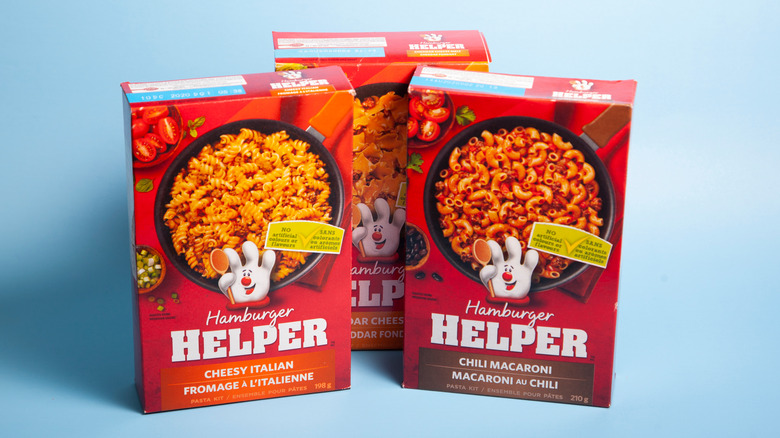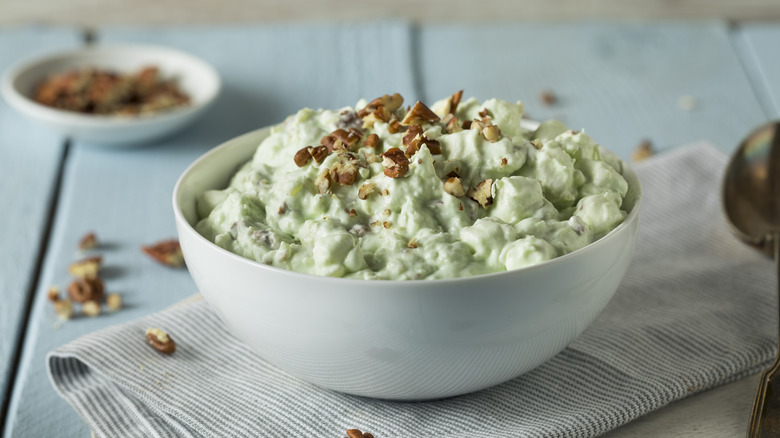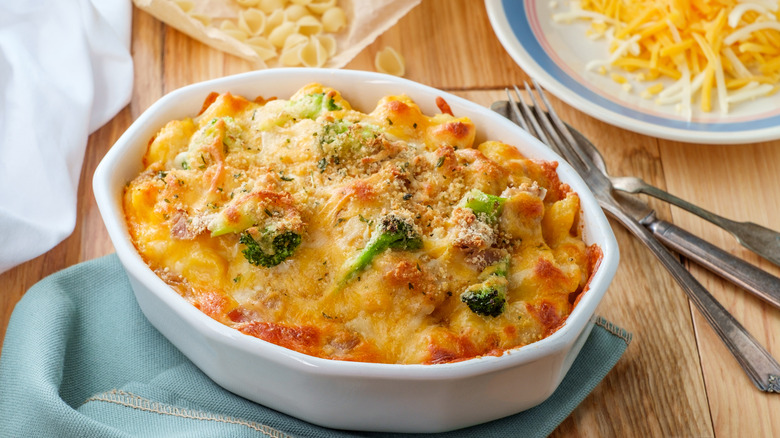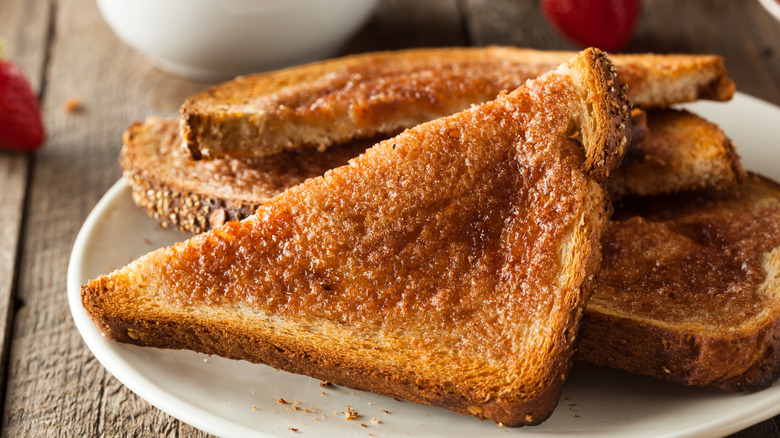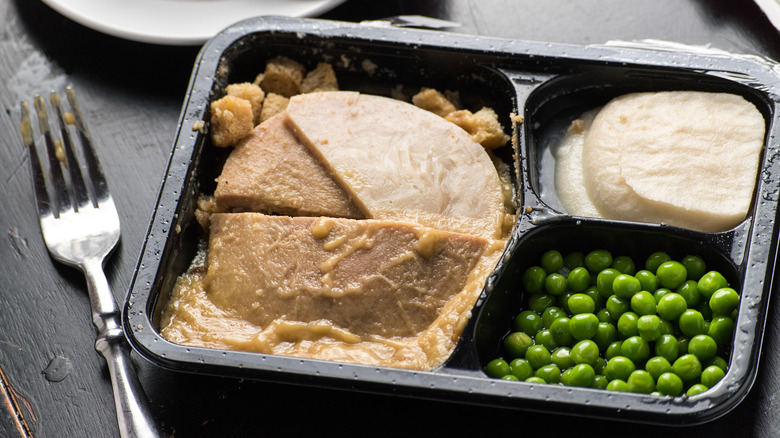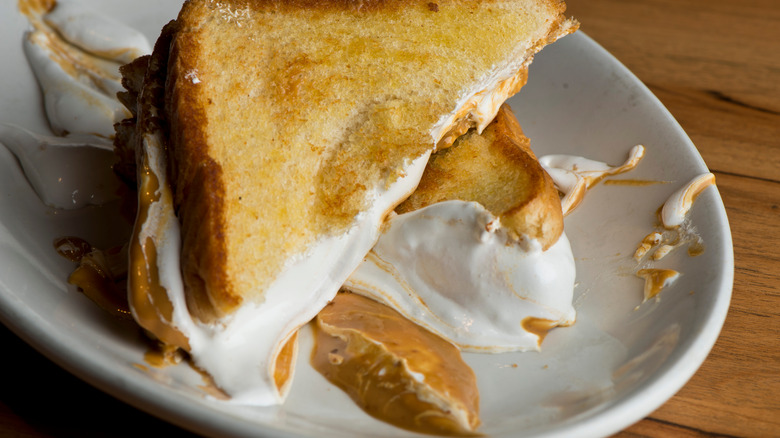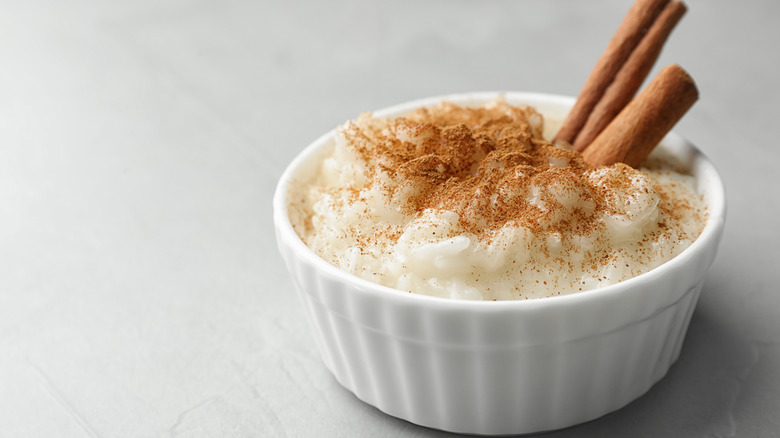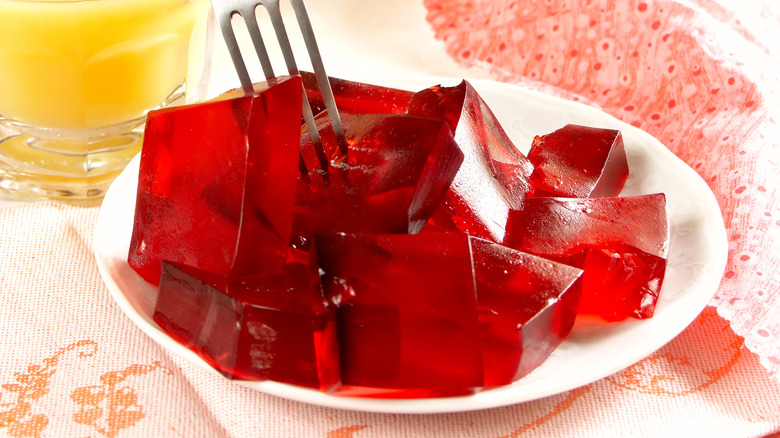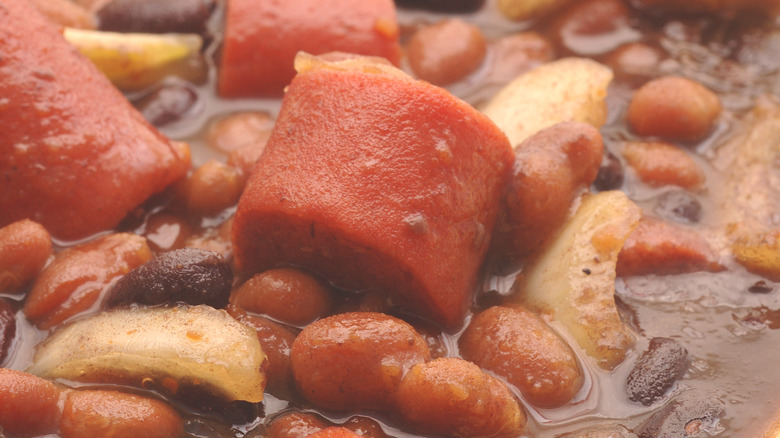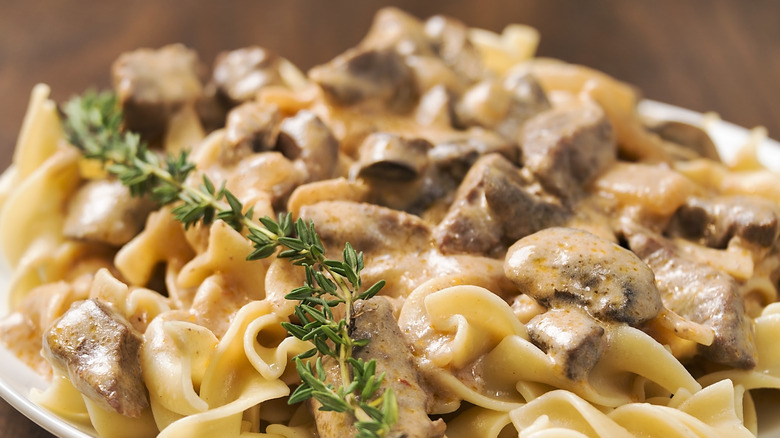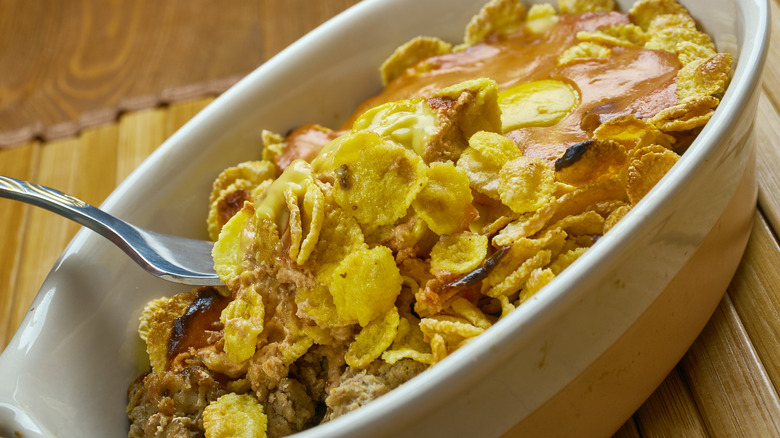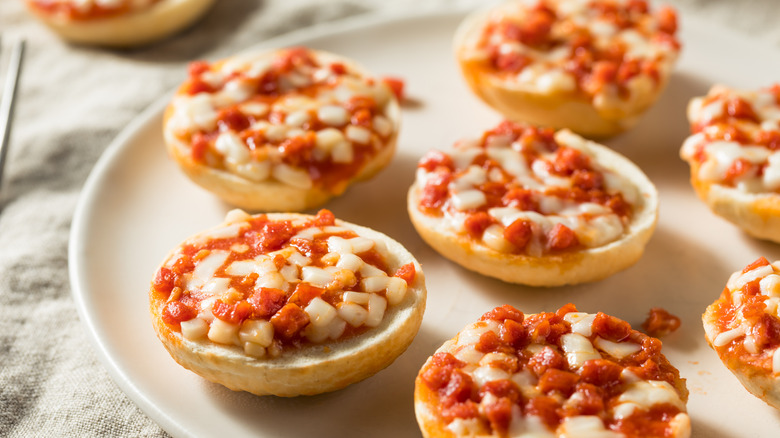23 Comfort Foods You May Have Forgotten About
We may receive a commission on purchases made from links.
Food carries emotional nourishment as much as it does nutritional. It's why comfort food crosses generations and cultures and why some comfort foods like meatloaf, macaroni and cheese, spaghetti and meatballs, and apple pie remain as popular in America today as they were 10 years ago. But, there are numerous comfort food dishes that used to make their way to American tables yet have since ceased to exist.
The exact science for why comfort foods "die out" is similar to that of food trends: Palates change, focus shifts to new novelties, and new opponents emerge to challenge our relationship with food. JSTOR Daily notes the popularity of so-called comfort foods has been challenged by veganism and trends like the Atkins or keto diet, which are structured on strict adherence to dietary rules and against indulging in certain foods simply for emotional gratification. Despite these challenges, recent world events and emotional turmoil have shifted many perspectives back to the true meaning of comfort food — comfort.
Here are some popular comfort foods that we might have forgotten about but could still make a comeback.
Sloppy Joes
A typical Sloppy Joe recipe is made from ground meat slathered in a savory tomato sauce and sandwiched between a bun. The first Sloppy Joe sandwich is believed to have originated in Sioux City, Iowa, where a cook named Joe began adding tomato sauce to "loose meat" sandwiches. But, this is one of multiple origins stories for the loose meat sandwich, which includes cheap ground beef as well as leftover ingredients used to stretch the meat, such as breadcrumbs, ketchup, and cheese. The relative price and filling quality of loose meat propelled many other comfort food dishes to surge in popularity in the 1930s and onwards, including meatballs, burgers, and meatloaf.
The modern Sloppy Joe, if you can still find it in diners and casual restaurants, can be made with a blend of other ground proteins besides beef. But, the classic sauce combination of Worcestershire sauce, ketchup, Dijon mustard, brown sugar, and apple juice remains the same. Just don't forget to grab a napkin!
Chicken pot pie
Chicken pot pie is the epitome of comfort food — flaky, buttery crust paired with an unctuous savory filling. Once you crack open the chicken pot pie, you'll reveal a swath of chicken pieces, celery, carrots, mushrooms, peas, and potatoes.
The history of the meat pot pie dates all the way back to the Roman Empire before it gained popularity in England. Pie Bar In 1796, the publication of "American Cookery" included recipes for strew pie, sea pie, and of course, chicken pot pie. The dish remained around through the era of industrialization in the United States and hits its crowning glory in the 1950s. World War II and the expansion of refrigeration technologies opened the opportunity for retailers to sell frozen chicken pot pies to consumers. Brands like Marie Callender and Stouffer's are still around today but have become less and less popular as consumers veer away from frozen meals.
Chipped beef on toast
Chipped beef on toast, better known as SOS or s*** on a shingle. Per War on the Rocks, the first published recipe for chipped beef was in the "Manual for Army Cooks" in 1910, and the recipe featured evaporated milk, which was shelf-stable and easy to transport, as well as the substitution of butter for shelf-stable lard. Chipped beef on toast lasted through the Depression era because it could be easily canned and cost significantly less than hot dogs or beef at the time.
Chipped beef is a salty ingredient that can be easily complemented with a quick gravy made from milk, butter, and flour. The toast used for chipped beef varies, but popular options include biscuits or plain white toast.
Salisbury steak
A Salisbury steak is a hybrid between meatloaf and a hamburger. The steak is served with a dark-colored gravy made from mushrooms and a flour roux, alongside mashed potatoes and steamed vegetables. The origins of the Salisbury steak is as a humble, high-protein meal for soldiers during the Civil War. The namesake for the meat was Dr. James Henry Salisbury, who was keenly aware of the dietary needs of soldiers. During the war, Salisbury added chipped beef to rations for a more direct source of protein, rather than the biscuits and vegetables that were typical at that time.
To be classified as a Salisbury steak, the USDA requires the patty to contain at least 65% meat and less than 30% fat. The product also must be sold completely cooked, which is why Salisbury steak was popular among frozen food retailers into the 1960s and 1970s.
Ambrosia salad
We all try to forget about old-fashioned ambrosia salad until that one relative brings a bowl of it to Thanksgiving dinner. For folks who have not had the pleasure of ambrosia salad, this decadent dessert does not resemble anything of a bowl of greens and vegetables. Instead, you'll find chunks of canned crushed pineapples, mandarin oranges, shredded coconut, maraschino cherries, and marshmallows, all coated in a whipped topping. Per the Alabama Chanin Journal, ambrosia (meaning "delicious" or "fragrant") appeared in Southern cookbooks in the late 1800s with the increased availability of citrus like mandarin oranges and pineapple in the United States.
Chicken à la King
Chicken à la King is a dish straight out of the 1970s. In reality, simmering chicken breast, mushrooms, pimento peppers, onions, and garlic in a bath of heavy cream and cream of chicken soup should be on everyone's "leftovers bucket list." According to What's Cooking America, it's believed that the first Chicken à la King was served to Wall Street son and horse breeder Foxhall P. Keene as "Chicken a' la Keene," before being renamed to the regal-sounding Chicken a' la King. In 1896, the first written recipe for Chicken àl a King was published in the "Boston Cooking School Cook Book," reports What's Cooking America.
Hamburger Helper
Hamburger Helper was the product of the 1970s beef shortage. Busy families who could not afford to purchase expensive ground meat were able to stretch their dollars by purchasing the pre-packaged pasta and seasoning mix-ins with 24 flavor options including Philly Cheesesteak, Cheeseburger Macaroni, Four Cheese Lasagna, and the dreaded Tuna Casserole flavors. Consumers would just have to buy their favorite flavor of boxed mix and add ground meat (or tuna, for the tuna casserole varieties), butter, milk, and water. The brand has since dissipated into the back of the consciousness of many Americans, even after the Hamburger Helper changed its marketing strategy toward single men in 2013.
Watergate salad
Watergate salad is like ambrosia salad, but with a nutty twist. Both ambrosia salad and Watergate salad share crushed pineapples, whipped topping, and mini marshmallows, but Watergate salad is made with pistachio pudding and chopped nuts as well. This ingredient gives Watergate salad a unique green hue. Despite its shared name with Washington D.C.'s most famous hotel, NPR notes the first recipe for Watergate salad was published a year after Nixon resigned and was likely made to poke fun at the ongoing investigation into the Nixon administration. As the country moved on from Watergate into the 1990s and 2000s, Watergate salad became less and less popular in American homes.
Hotdish
If ambrosia salad is Southern hospitality, then hotdish is midwestern hospitality. This meal can come in several different forms but usually contains a cream soup base, protein (hamburger being the most common), vegetable, starch (usually pasta or a potato product, such as tater tots), and a crispy topping. Meanwhile, "casserole" just means a dish that is made in a casserole pan.
It isn't uncommon for folks to add a layer of cheese to their hot dish for both flavor and texture. We're hoping that cheesy hash brown hotdish makes its way back into the American comfort food repertoire.
Tuna casserole
Tuna casserole rose in popularity in 1950 with Campbell's, but the first recipe for this nostalgic dish was originally published in cookbooks during the 1930s. Campbell's touted the tuna casserole as the original dump-and-bake recipe with relatively inexpensive pantry staples including canned tuna, noodles, vegetables, and condensed soup. Families started to use tuna casserole as both a weeknight dinner option and a staple for funerals, celebrations, and alike. Though most iterations of tuna casserole have been left in the 1950s, some modern recipes include the addition of carrots, peppers, broccoli, and reduced-sodium broth for a healthier weeknight dinner option.
Cinnamon sugar toast
If you had a sick day in the 1990s and early 2000s, you likely have eaten cinnamon toast for breakfast — and maybe dinner, too. This recipe requires only a few ingredients: toasted white bread, butter or margarine, and a sprinkle of cinnamon and sugar. The historical origins of this distinctly American comfort food are contested, but some sources suggest that the recipe is a derivative of milk toast. Milk toast is made by toasting bread and covering it in butter and condensed milk. While simple white bread is common for this recipe, brioche is also used for a more buttery flavor.
TV dinners
While we may think of TV dinners now as any meal eaten in front of a Netflix screen, the frozen TV dinner was a landmark invention that has since faded into oblivion. While there is some debate over how TV dinners kicked off in the 1960s, there are several important things that coincided with the invention of the frozen TV dinner — including the consumer availability of television and the radio, improvement of refrigeration technologies, and even the invention of the three-part tray that could separate the main components of the frozen dinner. The only question we have left is, frozen turkey dinner or lasagna with steamed vegetables?
Fluffernutter sandwiches
There isn't a more New England sandwich than a fluffernutter. The perfect fluffernutter sandwich is made with two slices of white bread sandwiching layers of creamy peanut butter and marshmallow fluff. There's nothing complicated about this simple, yet unique sandwich — except the overwhelming feeling of happiness and childhood nostalgia that will come over you when you bite into one.
According to Mental Floss, the exact root of the fluffernutter sandwich is deeply contested — but we do know that the sandwich is deeply rooted in the state of Massachusetts. The site says the development of the first shelf-stable marshmallow creme in the 1910s, as well as the wartime effort to reduce meat consumption, propelled this sandwich forward in New England lunch culture.
Tapioca pudding
No, we're not talking about the trendy boba pearls in your milk tea. Tapioca pudding is made from the cassava root, which is shaped into small pearls, and cooked down in a thick custard. The resulting texture is like the base of ice cream with the added textural element of the tapioca pearls. While vanilla is always a classic flavor for tapioca pudding, the recipe can also be modified for a tropical twist, such as with a mango-coconut tapioca pudding. And although finding and cooking a tapioca pudding always seems like an arduous process, products like minute tapioca make the process much easier.
Egg cream
The egg cream is an anomaly of a beverage. The New York Egg Cream was originally made with chocolate syrup, soda water, cream, and an egg for creaminess. However, as the Depression era loomed and eggs became more expensive, the egg was eliminated and more expensive cream was swapped for milk. Although the classic egg cream was made with chocolate flavor, it has evolved to include alcohol, spices like cinnamon and clove, and extracts like vanilla. The flavor is bubbly, yet significantly lighter in texture than a milkshake. If you're looking for a thick beverage that will clog your straw (and possibly your arteries), you might want to stick to the milkshake.
Welsh rarebit
Welsh rarebit: Is it just inside-out grilled cheese? According to Encyclopedia Brittanica, the answer is not really. This British pub food is made by melting a savory cheddar cheese sauce with ale, Worcestershire sauce, cayenne, mustard, and pepper over bread. The original recipe for this dish was likely the product of poverty in England. Welsh peasants didn't have enough money to afford meat so they opted for cheaper cheese instead. Although the recipe is rarely found in America, some pubs in England still offer this comfort food, served with an egg on top (buck rarebit), and almost always with a pint of beer.
Rice pudding
Rice pudding is a sweet dessert that can be baked, cooked in a saucepan, or served cold. Regardless of the preparation method you choose for rice pudding, it's always bound to fill you up and satisfy your craving for something sweet. The typical ingredients for rice pudding include milk, evaporated milk, and sugar, but rice pudding can include more exotic ingredients like cinnamon, mango, apples, and peaches.
Rice pudding peaked in popularity as comfort food in the 18th and 19th centuries, as noted by Greengos Cantina, because it was a simple way to stretch leftover rice. Prior to being introduced to Europe, the site says rice pudding was especially popular in China and India, where the dish was widely eaten as early as the 15th century.
Jell-O
The squishy, comfort food called Jell-O has been around for longer than you'd think. New York entrepreneur Peter Cooper released the first powdered gelatin product in the 1840s, and after several product revamps, failed sales, and consumer skepticism, Jell-O reached its peak in the 1920s and 1930s since home cooks could prepare the dish easily — with just hot water and time in the refrigerator. Eventually, Jell-O went on to be served as a popular dessert option in hospitals, made into "Jell-O salads" and bundts with vegetables and fruits, or eaten in glasses in classic American diners. CNN attributes the decline in Jell-O sales to competition with other snack brands — but we think it may have something to do with the texture.
Beans-n-Franks
Beans-n-Franks are a canned comfort food also sold under the moniker "beanie weenies" or simply frank and beans. According to National Today, the combination of the two separate American comfort foods was available on the market in the 1980s. Besides opting for the canned product, American families used to enjoy adding sliced hot dogs to slow cookers filled with beans. New England Today finds the dish was often served with another New England classic (surprisingly found in cans), brown bread.
There isn't an exact reason why Beans-n-Franks has faded into the periphery of comfort foods. The University of Wyoming Extension suggests that the high sodium levels in canned foods and the movement away from processed meats like hot dogs may be potential reasons people are leaving beenie weenies on the shelf.
Beef stroganoff
Beef stroganoff has been gracing plates for many years. According to Fork and Plate, beef stroganoff began as a dish for the Russian high society, and in the 1920s, the migration of Russian populations to the United States brought foods like beef stroganoff to new shores. The first recipe for beef stroganoff was published in the United States in 1932, according to the site. Beef stroganoff, for the unfamiliar, is a noodle made with sirloin or rib eye steaks and cream sauce made with sliced mushrooms, sour cream, and mustard served over egg noodles (vegan mushroom stroganoff is a newer iteration). The dish can also be stewed with more dense cuts of meat like beef chuck.
Peanut brittle
If biting into a crisp, nutty piece of caramel-and-peanut goodness is your idea of a fun time, you might consider asking your grandma for her peanut brittle recipe. According to Candy Favorites, peanut brittle was originally created as a mistake; a Southern baker added baking soda to taffy instead of cream of tartar. This meant the brittle broke into shards rather than staying stringy.
Peanut brittle only requires a few simple ingredients and a basic understanding of candy making. The sugar, cornstarch, and water are heated until the sugar begins to change color. Then, the peanut butter and chopped peanuts are added to the pot before the brittle is cooled on a sheet. All that's left to do is crack the sheet into shards and dig in.
Frito pie
Frito pie is a dish straight out of a tailgate party. Not only is the dish a great dish for gatherings, but a simple Frito pie recipe can also be served as a weeknight dinner dish. To make Frito pie, a base of beef and bean chili is topped with cheese and crumbled corn chips. The dish is then baked in an oven until the cheese is gooey. It's the ultimate comfort dish that can be upgraded with different kinds of beans, vegetables, or spicy corn chips instead of plain ones. We're still trying to find out why Frito pie has ceased to dominate the comfort food arena, but the decline of home cooking may be one of them.
Pizza bagels
Pizza bagels: They're the ultimate drunk dorm room or middle school sleepover comfort food. Pizza bagels, which are also sold under the frozen food moniker "bagel bites," feature a mini-bagel base covered in cheese, tomato sauce, and toppings. If you've ever sunk your teeth into a warm pizza bagel, you can thank Harry Katz, owner of the Park Street bagel bakery in Boston. Others attribute the pizza bagel to west coast resident Bruce Treitman. Regardless of who actually decided to combine the combination of bagels and pizza, we are forever grateful.

